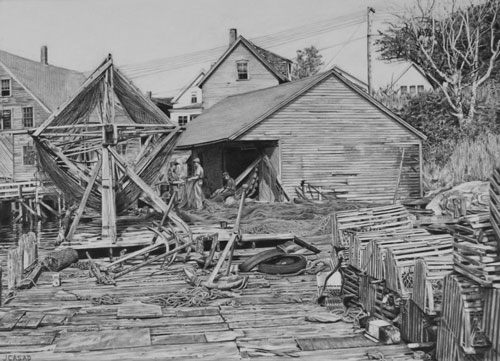Casad Digs Clams and Draws the Coast
by Steve Cartwright

When you see a Jen Casad picture, you could easily mistake it for a fine black and white photograph. Her detailed, accurate pencil drawings document the midcoast fishery, and her work has recently been on exhibit at a New York City gallery. She is excited about an upcoming exhibit at a maritime museum in Spain.
“I dig clams. Dug my way through school,” said artist Jen Casad of Boothbay. It is still part of this artist’s life; “clams in the summertime, art in the wintertime.”
She is already on film; a few years ago she was the subject of Double Tide, a 99-minute art film featuring Casad digging two low tides in one day with no dialog. It’s been screened at New York’s Museum of Modern Art and received favorable comment in The New York Times.
The Alexandre Gallery featured works such as Osier’s Wharf in South Bristol, a spot that is almost sacred to Casad because it’s the last place she saw her father alive.
Clamming “pays the bills,” said Casad, who laughs easily and smiles a lot, sometimes in the face of adversity. “And art is starting to.” She lives in a half-renovated one-room schoolhouse not far from saltwater. Her smile belies a tough early life: Her father disappeared with a fishing boat when she was very young, in 1980. No trace of the vessel was ever found. Her mother has struggled with disability. Her stepfather died of cancer.
She is proud that her 94-year-old Norwegian grandmother is an artist, and that her father, too, was an artist, and there are others in her family tree.
Now Casad, 34, is balancing motherhood with art and fishing, her new baby, Elizabeth, on her knee or in the nearby lobster trap cradle built by a friend. A baby is a job, a big commitment for Casad and her partner, clamdigger Kris Peters. “Art is going to be on the back burner.” Still, she envisions taking Liza, as the baby is called, out to sea with her. “It’s addictive, to be out on the water. Fishermen,” she said, “have this amazing connection to the environment.”
The gritty, grueling work of clamming, lobstering and catching fin fish is her subject matter, along with the sheer beauty of sea and shore, from a clamshell to spruce trees in the fog. She identifies with fishing and the freedom of being on your own. “There’s no way you’re going to put any of the fishermen in an office job,” she said. “I get my inspiration from being outside. I find the hard-working people so real.”
She graduated from Lincoln Academy in Newcastle, then from the University of Maine at Augusta with a degree in art. She credits contemporary artist John Whalley’s realist Maine paintings for inspiring her to “realize that I could continue working in pencil, and be acknowledged and successful – unlike what everyone else was telling me: go back to painting.” She said she has been influenced by the intricate Renaissance engravings of Albrecht Dürer and 19th century paintings by bohemian artist James Abbott McNeill Whistler.
Whalley, who has a gallery in Damariscotta Mills, said he was impressed years ago with Casad’s fine-lined work. “I just loved seeing what she’s doing. It’s so neat. Her story is; that’s her life. She’s one of them (the local fishermen). You can see the knowledge of her subject in her drawing.” Whalley said he was impressed with both the Double Tide film and Casad’s gallery show in New York.
Casad spent her first childhood years in the Sheepscot River hamlet of Alna, and then lived in the fishing community of South Bristol on the Damariscotta River. An independent spirit, she achieved legal emancipation at 16 and moved in with friends, taking a job at a Newcastle import store, Mexicali Blues.
She tried picking snails instead, and found she could make more in three hours on the shore than eight hours in the store. “That was the beginning of no return” to being employed by someone else, she said.
After college, she apprenticed as a sternman for three years to David Rice, fishing out of the South Bristol Fishermen’s Co-op. She’d like to have her own lobstering license but it’s increasingly hard to get one, so it’s back to the clam flats. She’s been on a waiting list for a lobster license for at least four years.
Meantime, Casad will keep on digging clams, drawing her seascapes and breastfeeding her new baby. She sees herself as presenting an insider’s vision of Maine, where so many artists are from outside the state. Maine and the fishery are “part of who I am, part of my story,” she said. “It isn’t like I’m a tourist standing on the dock.”
